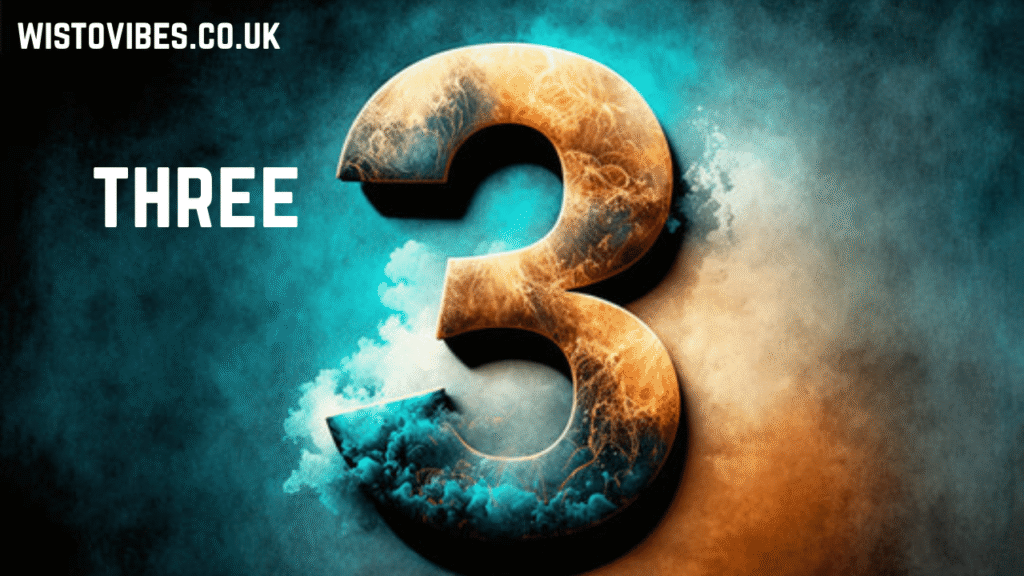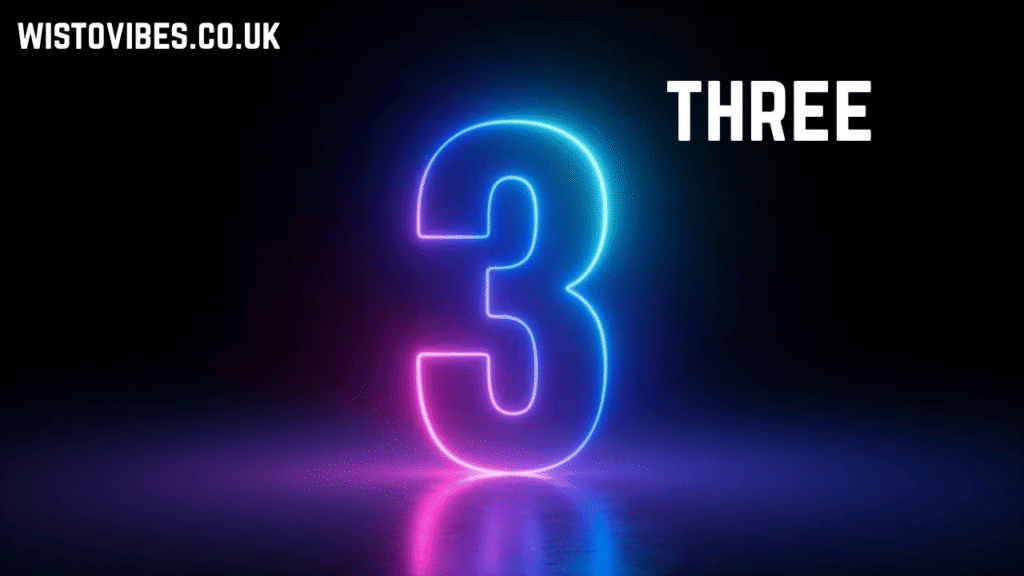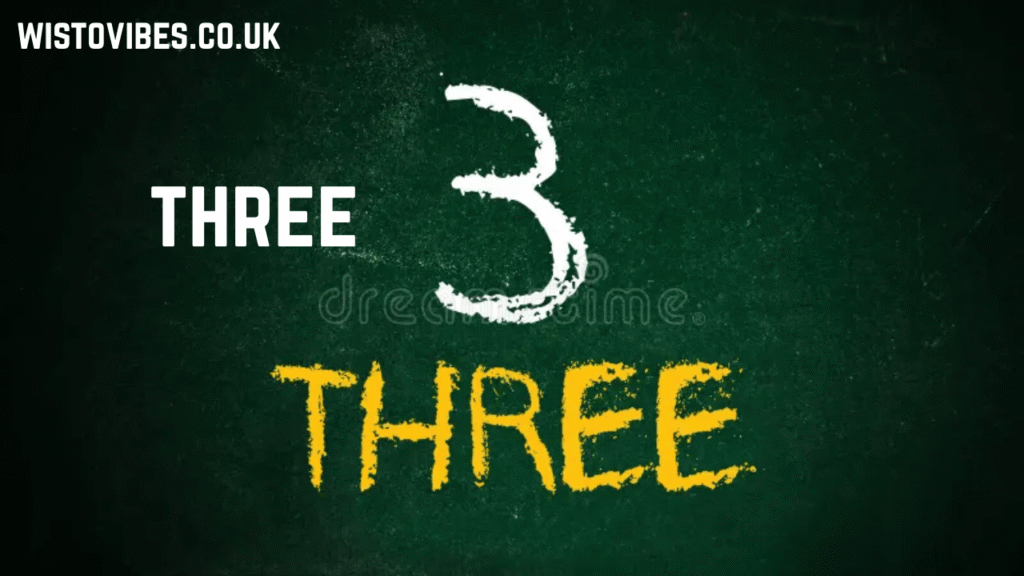The number “three” has always carried a unique resonance in human history, language, and thought. Across civilizations and eras, “three” emerges as a symbol of completeness, harmony, and transformation. It represents balance—something between duality and infinity—standing as a bridge between opposites. Whether in religion, philosophy, art, or science, “three” holds a central place in our collective consciousness. To understand “three” is to explore how humanity interprets order, beauty, and meaning in the world.
Three as a Universal Symbol

“Three” is not just a number; it is an archetype. The concept of “three” is embedded in myths, traditions, and everyday expressions. Triads or triplets of symbols—such as the beginning, middle, and end—reflect life’s natural cycles. When something appears in “three,” it tends to carry authority and power, capturing attention and remaining memorable. From storytelling structures to sacred rituals, “three” is universally regarded as the smallest complete set.
The Role of Three in Religion
Religion offers some of the strongest examples of “three” as sacred. In Christianity, the Holy Trinity—Father, Son, and Holy Spirit—symbolizes divine unity in multiplicity. In Hinduism, “three” is found in the Trimurti: Brahma the creator, Vishnu the preserver, and Shiva the destroyer. Buddhism emphasizes the Triple Gem—Buddha, Dharma, and Sangha—as its spiritual foundation. Across faiths, “three” represents wholeness, divinity, and a cycle of existence that transcends time.
Three in Philosophy and Thought

Philosophers have long considered “three” as essential for logic and argument. A thesis, an antithesis, and a synthesis create the dialectical method used to resolve contradictions and discover truth. The notion of “three” provides balance, where two opposing forces are harmonized by a third, leading to progress and clarity. Without “three,” reasoning often falls into polarity and conflict; with “three,” reconciliation becomes possible.
The Natural World and Three

Nature too follows the rhythm of “three.” Time divides into past, present, and future. Life itself moves through three stages: birth, growth, and death. Even the physical world is structured through three dimensions—length, width, and height—that make up our experience of space. These recurring patterns show that “three” is not simply human invention but also a reflection of natural order.
Three in Mythology and Folklore
Myths across cultures embed “three” as a key pattern. In Greek mythology, the three Fates control human destiny. Norse legends speak of the three Norns, weaving the fabric of past, present, and future. Fairy tales repeat “three” endlessly—three wishes, three challenges, or three siblings—because repetition in threes makes stories resonate and stick in memory. Through folklore, “three” became a storytelling rhythm that still echoes in modern literature and cinema.
Three in Language and Expression
The human voice naturally turns to “three” in communication. Popular phrases like “life, liberty, and happiness” or “mind, body, and spirit” show the strength of triads. Even jokes are often structured in “three” parts for maximum effect. Writers and speakers know that “three” carries cadence and completeness, anchoring meaning in a way that feels satisfying to listeners and readers alike.
Three in Human Relationships
The number “three” often symbolizes balance in relationships. A pair can be oppositional or incomplete, but adding a “third” creates harmony. The bond of parents and child is one of the most fundamental triads in human society. Even friendships and communities often thrive in groups of “three,” allowing cooperation, mediation, and richer interaction. Human connection itself finds strength in this triadic balance.
Three in Art and Aesthetics
Artists and architects have used “three” as a guiding principle for centuries. The “rule of thirds” in design creates balance and focus, while three-point perspective in drawing allows depth and realism. Triangular compositions in painting bring stability and movement simultaneously. In aesthetics, “three” becomes the secret formula for proportion, rhythm, and harmony.
Three in Science and Mathematics
Science also reflects the significance of “three.” The atom, as the foundation of matter, is built from three main particles: protons, neutrons, and electrons. In physics, Newton’s three laws of motion laid the groundwork for classical mechanics. Chemistry’s states of matter—solid, liquid, and gas—highlight another triadic pattern. Mathematics too elevates “three” as the first odd prime, the basis of geometry’s simplest polygon, the triangle.
Three in Psychology and Mind
Psychologists often interpret “three” as a model for understanding human behavior and consciousness. Freud divided the psyche into id, ego, and superego. Cognitive models often categorize learning or memory into three stages. In personal growth, “three” stages—awareness, action, and transformation—are frequently used frameworks. This triadic view allows for deeper exploration of how the mind balances instinct, reason, and morality.
Three in Life’s Journey
Life itself often feels like it unfolds in “three.” Youth, adulthood, and old age define the rhythm of human existence. Major decisions and turning points often appear as threefold choices—past, present, and future pathways. Cultural ceremonies too emphasize “three,” from birth rituals to marriage vows to memorial traditions. Human lives are organized around this tripartite understanding, giving shape to experience and meaning.
Three in Storytelling and Drama
Great narratives are built on “three.” Aristotle’s classical structure—beginning, middle, and end—still dominates literature and cinema. Screenplays often use three acts: setup, confrontation, and resolution. Comedians rely on three-punch jokes, while speeches move in triads for impact. Audiences instinctively respond to “three” because it provides rhythm, suspense, and closure in stories.
Three in Symbolic Triangles
The triangle, as the geometric representation of “three,” holds deep symbolic meaning. It is the most stable of shapes, appearing in bridges, pyramids, and architecture. Spiritually, upward-pointing triangles signify aspiration and divinity, while downward triangles symbolize grounding and receptivity. Triangles unite opposites through a third point, embodying the harmony of “three.”
Three in Cultural Traditions
Cultural customs worldwide emphasize “three.” Many societies believe in luck arriving in “threes,” whether good or bad. Ceremonial chants often repeat phrases three times to enhance their power. In weddings, rituals like circling three times or lighting three candles symbolize unity. From East to West, cultural practices recognize “three” as a number of significance and completion.
The Mystery of Three in Dreams and Symbols
Dreams often feature “three” as a mysterious symbol. Encountering three objects, people, or paths can signify choices or transitions in life. Symbolists and psychologists interpret these dreams as representing balance, unity, or spiritual awakening. When “three” emerges in dreams, it points to transformation—an inner signal of change and integration.
Three in Modern Society
In modern life, “three” still shapes our world. Businesses emphasize “three” steps in branding slogans or advertising for memorability. Political systems are often structured around three powers: legislative, executive, and judicial. Even in technology, triple redundancy ensures reliability in systems. Our societies still mirror the ancient truth that “three” embodies strength and completeness.
Why Three Resonates with Humanity
The lasting power of “three” lies in its psychological and symbolic resonance. It satisfies human craving for balance and order while still allowing movement and growth. Where “two” may create tension, “three” resolves it with completion. This simple number reflects the complexity of life and the beauty of harmony, which explains why humanity continues to embrace “three” in culture, science, and art.
Conclusion: The Eternal Significance of “Three”
“Three” is far more than a numeral—it is a principle, a rhythm, and a universal truth. In religion, philosophy, nature, art, and human life, it captures the essence of balance and transformation. The significance of “three” will continue to inspire societies, guiding how we think, speak, and create. Its symbolism is eternal, reminding us that unity is strongest when expressed in triplets.
FAQs
Why is “three” considered lucky?
Many cultures believe “three” is lucky because it represents completeness and harmony, offering balance between opposites.
How does “three” appear in daily life?
Time, language, stories, and even design principles often follow patterns of “three,” making it a constant presence.
What religions value “three”?
Christianity, Hinduism, and Buddhism—among others—view “three” as sacred, using it to represent divinity and cosmic order.
Why do stories often repeat things three times?
Repetition in threes is memorable and satisfying, creating rhythm and resolution in storytelling.
What does “three” symbolize in psychology?
It symbolizes balance and completeness, such as in Freud’s model of id, ego, and superego, or stages of personal growth.
Read More: Ovira Reviews An In Depth Look at a Modern Pain Relief Solution




